The Guthrie National Bank Of Guthrie
The Guthrie National Bank Of Guthrie in Oklahoma printed $2,038,750 dollars worth of national currency. Over $1,000,000 face value is a lot of money. However, some types and denominations of currency from this bank could still be rare. This national bank opened in 1890 and stopped printing money in 1935, which equals a 46 year printing period. That is a fairly normal lifespan for a national bank. During its life, The Guthrie National Bank Of Guthrie issued 10 different types and denominations of national currency. We have examples of the types listed below. Your bank note should look similar. Just the bank name will be different. For the record, The Guthrie National Bank Of Guthrie was located in Logan County. It was assigned charter number 4348.
We buy all national currency. Please call or email us for a quote. Sales@AntiqueMoney.com
The Guthrie National Bank Of Guthrie in Oklahoma printed 4,000 sheets of $5 1882 territorial brown back national bank notes. That printing range is high enough to allow for a couple of survivors, but not much more. 1882 five dollar territorial brown backs are the lifeblood of the territorial collecting community. They were issued by virtually every territory (with exception of Alaska, Nebraska, and Porto Rico). A total of 109 national banks printed $5 brown back territorials. There are around 120 notes known to exist. That is a pretty high survival rate. Ironically though, the fact that lots of these exist is part of the reason that they are so collectible. More than one collector can reasonably try to put together a set. Ultra-rarities are always expensive, but often times they end up as outliers to collections. 1882 five dollar brown backs have always been popular. When you combine that with the appeal of a territorial, then you have a real winner. You can contact us to learn the true value and rarity of your note. In the meantime, take the number of sheets printed and multiply it by four, that will give you the total number of 1882 $5 territorials issued.
Series of 1882 $5 Territorial Brown Back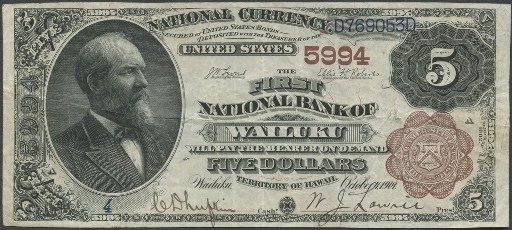
The Guthrie National Bank Of Guthrie printed 1,000 sheets of $10 1882 territorial brown back national bank notes. A total sheet output in the lows 1,000s is a great sign that you own a very rare bank note. The ten dollar 1882 territorial brown back was printed by more than 200 national banks, and more than 200 pieces are known to exist today. That number tends to go up by a handful each year as more are discovered. Often times the $10 territorial was the first and lowest denomination a bank received. About a dozen #1 specimens are held by collectors today, and there are probably many more still held by descendants of early pioneer bankers. Territorial bank notes are the cream of the crop when it comes to national bank notes. Most are at least rare and some can be very valuable. As always, the exact value is still based on bank of issue and condition. Something ugly from Oklahoma might only be worth $3,000, but other examples could be worth well over $10,000.
Series of 1882 $10 Territorial Brown Back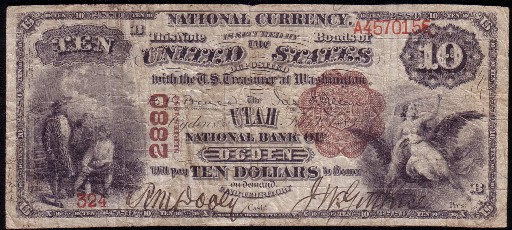
The Guthrie National Bank Of Guthrie also printed 1,000 sheets of $20 1882 territorial brown back national bank notes. That number also represents the total number of twenty dollar bills printed for the type. Whether you have a ten or a twenty dollar territorial brown back, you should work with an expert to establish the value. Twenty dollar notes from this series were only printed at the rate of one to three compared to tens, but sadly, $20 1882 brown backs really don’t command a premium for their extra rarity. Only around fifty are known to exist today.
Series of 1882 $20 Territorial Brown Back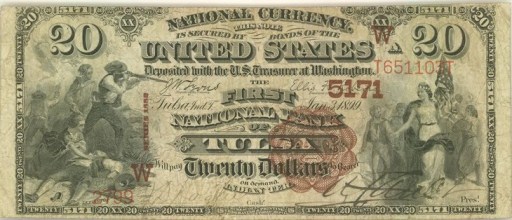
The Guthrie National Bank Of Guthrie also printed 1,688 sheets of $50 1882 territorial brown back national bank notes. A total sheet output in the lows 1,000s is a great sign that you own a very rare bank note. The $50 1882 territorial brown back is a great rarity. Only two are known to exist. You have to remember that $50 was a large sum of money during the time these were originally printed, which started in 1882 and lasted until 1908 (on very rare occasions). People could save a coin or maybe even a five dollar bill as a curiosity item or a keepsake. No one really wanted to tie up $50 for the foreseeable future. There was no collectible paper currency market until the 1950s. So even if you had something like this sixty years after it was originally printed, it was still just worth the face value of $50. Of course that has all changed today. These are now great rarities appreciated by the collecting hobby.
Series of 1882 $50 Territorial Brown Back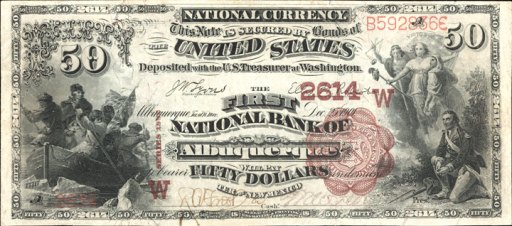
The Guthrie National Bank Of Guthrie also printed 1,688 sheets of $100 1882 territorial brown back national bank notes. That is the same output for individual $50 bills. Most regular issue $100 brown backs are worth around $5,000. However, we are talking about territorial $100 brown backs. These are much rarer. In fact, they were only printed by a total of 25 different national banks and only about ten are known to exist! So needless to say, these are quite rare. This high denomination was printed by all of the usual territories you expect to see: Montana, Washington, Arizona, Hawaii, North Dakota, New Mexico, Oklahoma, South Dakota, and Utah. The notes that are known to exist are split between Oklahoma, Utah, and New Mexico. So if you have a new state, then that will certainly be in demand.
Series of 1882 $100 Territorial Brown Back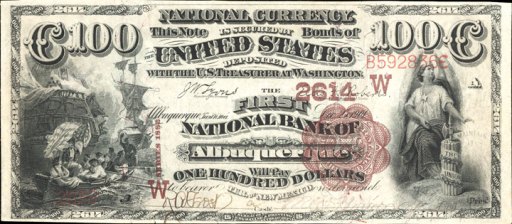
The Guthrie National Bank Of Guthrie also printed 1,745 sheets of $5 1882 blue seal national bank notes. 1882 blue seals are traditionally not the most popular national bank notes. However, when we are talking about such a low print number, these become much more desirable. 1882 $5 blue seal bank notes were issued by some national banks in The United States. While these are a somewhat rarer issue, they just aren’t especially popular with collectors. With exception of some minor differences, they look exactly like the earlier brown back series. Most collectors would prefer the brown back notes. With that said, some 1882 blue seals can still be worth thousands of dollars. So don’t just assume that what you have is automatically common.
1882 Blue Seal $5 National Bank Note
The Guthrie National Bank Of Guthrie also printed 792 sheets of $10 1882 blue seal national bank notes. 1882 blue seals are traditionally not the most popular national bank notes. However, when we are talking about such a low print number, these become much more desirable. All of these notes say series of 1882 but they were actually printed between 1908 and 1921. So they aren’t quite as old as the dates might suggest. There is also a date on these notes that is between 1888 and 1901. That date is written in cursive text and it represents when the bank was chartered or re-chartered. Some of the so called 1882 value back notes have a chance to be really rare. Most of the earlier notes that say 1882-1908 on the back are likely going to be relatively common. The designs are exactly the same on the front. Each has a blue seal and charter number.
1882 Blue Seal $10 National Bank Note
The Guthrie National Bank Of Guthrie also printed 792 sheets of $20 1882 blue seal national bank notes. That is the same number of sheets as the ten dollar denomination. You don’t have to multiply by three to get the exact number of notes issued though. There was only one twenty dollar bill per sheet. As with any national bank note, the exact value is still based on the condition, serial number, and bank of issue.
1882 Blue Seal $20 National Bank Note
The Guthrie National Bank Of Guthrie also printed 3,336 sheets of $5 1902 blue seal national bank notes. Many small national banks could be in business for years and only print between 2,500 and 5,000 sheets of blue seals. Ben Harrison is on the front of all 1902 $5 blue seal bank notes. This happens to be the smallest denomination issued for the 1902 series. Each note is complete with a blue seal and blue charter number. Despite saying series of 1902, these were actually issued by national banks between 1908 and 1928. There are two different types of blue seals. The first type is called a date back and it has “1902-1908” written on the back of the bill. The other type is called a plain back; it does not have the date stamps on the back of the bill. The values for these notes range widely based on condition and the bank of issue.
1902 $5 Blue Seal National Bank Note
The Guthrie National Bank Of Guthrie also printed 2,842 sheets of $10 1902 blue seal national bank notes. Many small national banks could be in business for years and only print between 2,500 and 5,000 sheets of blue seals. 1902 $10 blue seal bank notes all have a portrait of William McKinley on them. Values can range from as little as $40 up to over $10,000. There really is no trick to know what is rare and what is common by just doing an internet search. You really need to work with an expert (like us) in order to determine the value of your specific bank note. There are at least ten different factors than can make some 1902 $10 blue seals worth more than others. We know exactly what to look for and we would be happy to provide a free appraisal and our best offer.
1902 $10 Blue Seal National Bank Note



